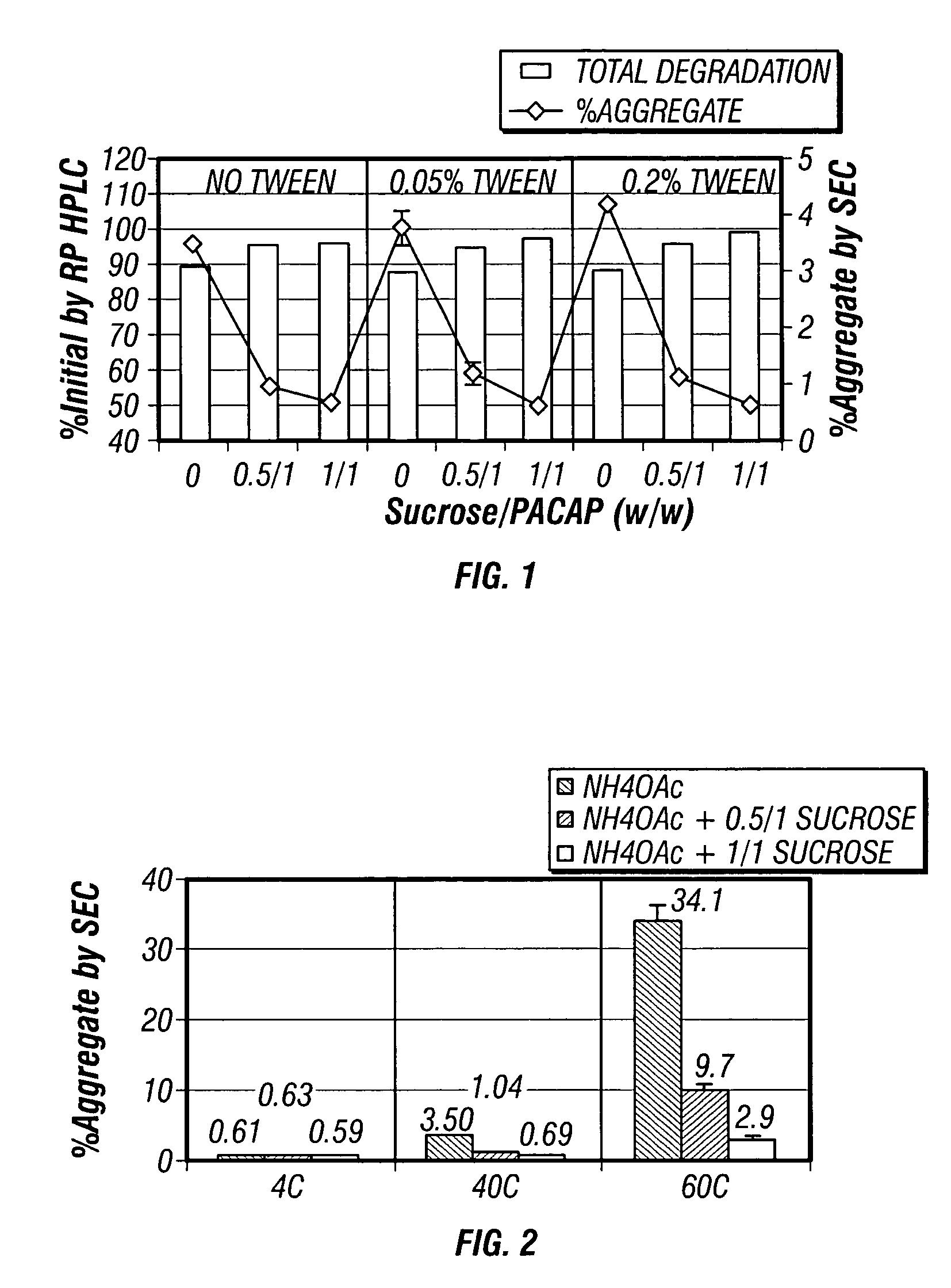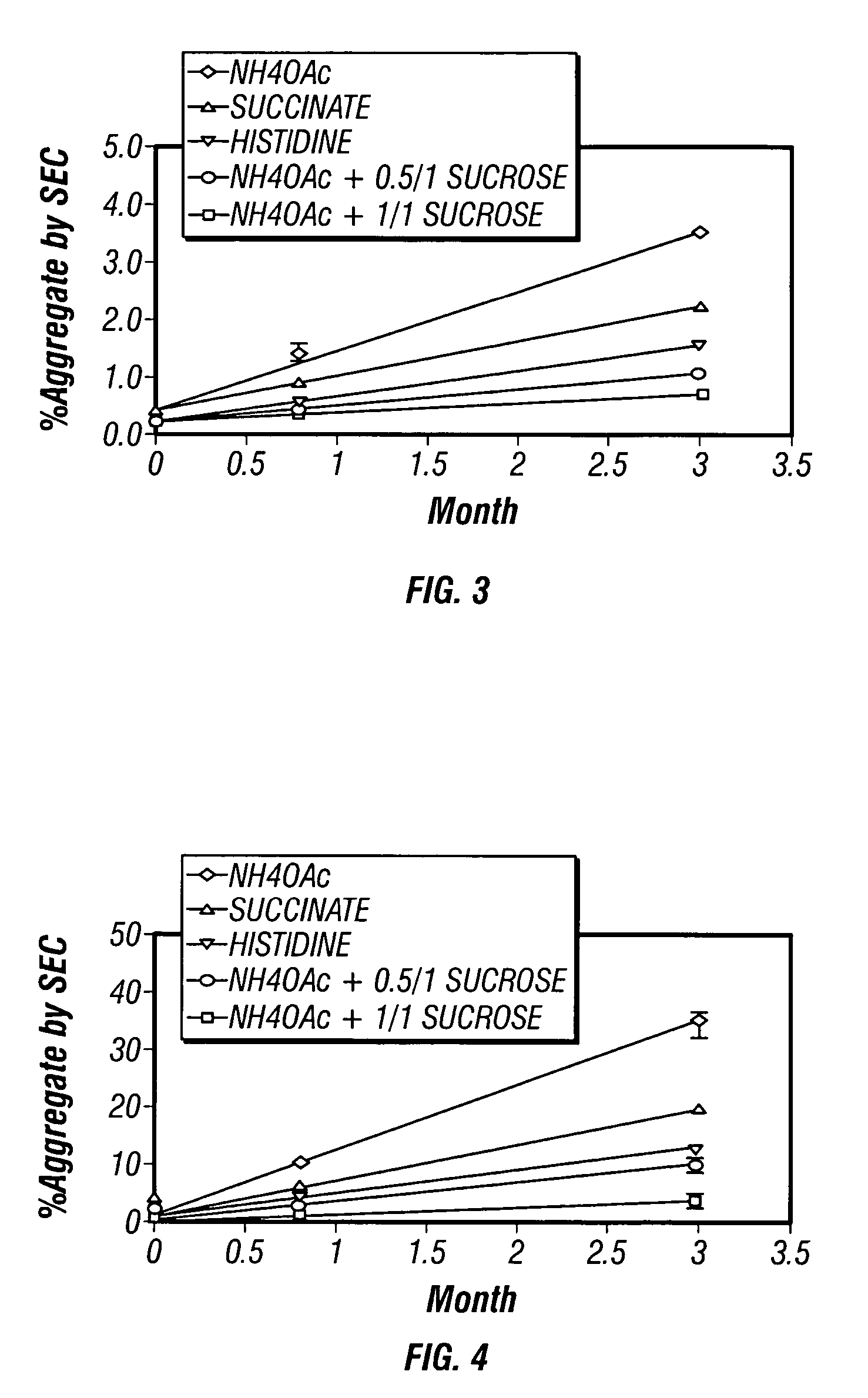Stabilized, solid-state polypeptide particles
a solid-state polypeptide and stabilizing sugar technology, which is applied in the direction of peptides, peptide/protein ingredients, inorganic non-active ingredients, etc., can solve the problems of difficult to maintain the stability of therapeutic polypeptides loaded, degraded polypeptides contained in the solution or suspension, and large amounts of stabilizing sugar in the formulation of polypeptide formulations, etc., to achieve excellent polypeptide stabilization, facilitate the formulation of suspensions, and higher concentrations
- Summary
- Abstract
- Description
- Claims
- Application Information
AI Technical Summary
Benefits of technology
Problems solved by technology
Method used
Image
Examples
example 1
[0051] Due to the nature of the suspension vehicles used in implantable drug delivery systems, mixing of the suspension formulation bulk and subsequent loading of the suspension formulation into the implantable systems are often conducted at elevated temperatures. To evaluate the stability of PACAP analog (or simply “PACAP”) suspended in various suspension vehicles at elevated temperatures, unprotected, lyophilized PACAP was suspended in four different suspension vehicles (LL / GML / PVP, BA / PVP, EHL / PVP, and PEG / PVP). To suspend the PACAP into the suspension vehicles 3.3 mg PACAP acetate was manually mixed into each of the different suspensions to achieve a PACAP content of approximately 3%. The stability of the PACAP suspension formulations was then evaluated after incubation at 65° C. for four hours. The stability of the prepared PACAP suspensions was evaluated by RP-HPLC and SEC, and as can be seen by reference to Table 1, the results showed that PACAP was stable throughout the four...
example 2
[0053] The preliminary findings from the processing study led to the evaluation of the stabilization effect of sugar (sucrose) and nonionic surfactant (Tween 80) on PACAP lyophiles and suspensions. In order to carry out the evaluation, samples were prepared with PACAP in 10 mM NH4OAc (pH6.4) at 3 levels of Tween 80 (0, 0.05, 0.2 wt %) and sucrose (0, 0.5 / 1, 1 / 1, w / w). A solution of PACAP in 10 mM of histidine (pH 6.4) and sodium succinate (pH 5.6) was also prepared. Each of the PACAP solutions were lyophilized to obtain reconstituted, solid-state PACAP particles, and individual vials were provided 3.3 mg samples of the material reconstituted from each of the solutions, with the samples containing (1) no additive, (2) 0.2 wt % Tween 80, (3) 0.2 wt % Tween 80+0.5:1, w / w sucrose, and (4) 1:1, w / w sucrose. The various 3.3 mg samples were manually mixed with LL / GML / PVP and BA / PVP to provide suspension formulations having about 3% PACAP content, and the suspension formulations were subjec...
example 3
[0061] Solid-state PACAP particles were prepared via a lyophilization process (FTS Duro stop) from three different polypeptide solutions prepared in NH4OAc buffer at pH6. Each of the three different solutions contained a different amount of sucrose, with the first containing no sucrose, the second containing a weight ratio of sucrose to PACAP of 0.5 / 1, and the third containing a weight ratio of sucrose to PACAP 1 / 1. Solid-state PACAP particles prepared from each of the three solutions were stored at control temperatures ranging from 2° C. to 8° C., a temperature approximating physiologic temperature (40° C.), and a temperature exceeding physiologic temperature (60° C.). The stability of the PACAP contained within each group of solid-state PACAP particles was assessed at 24 days and 3 months. To assess PACAP stability within each group of particles, the particles were reconstituted in water and analyzed by reversed-phase RP-HPLC (acetonitrile gradient elution with mobile phase contai...
PUM
| Property | Measurement | Unit |
|---|---|---|
| wt % | aaaaa | aaaaa |
| wt % | aaaaa | aaaaa |
| pH | aaaaa | aaaaa |
Abstract
Description
Claims
Application Information
 Login to View More
Login to View More - R&D
- Intellectual Property
- Life Sciences
- Materials
- Tech Scout
- Unparalleled Data Quality
- Higher Quality Content
- 60% Fewer Hallucinations
Browse by: Latest US Patents, China's latest patents, Technical Efficacy Thesaurus, Application Domain, Technology Topic, Popular Technical Reports.
© 2025 PatSnap. All rights reserved.Legal|Privacy policy|Modern Slavery Act Transparency Statement|Sitemap|About US| Contact US: help@patsnap.com



